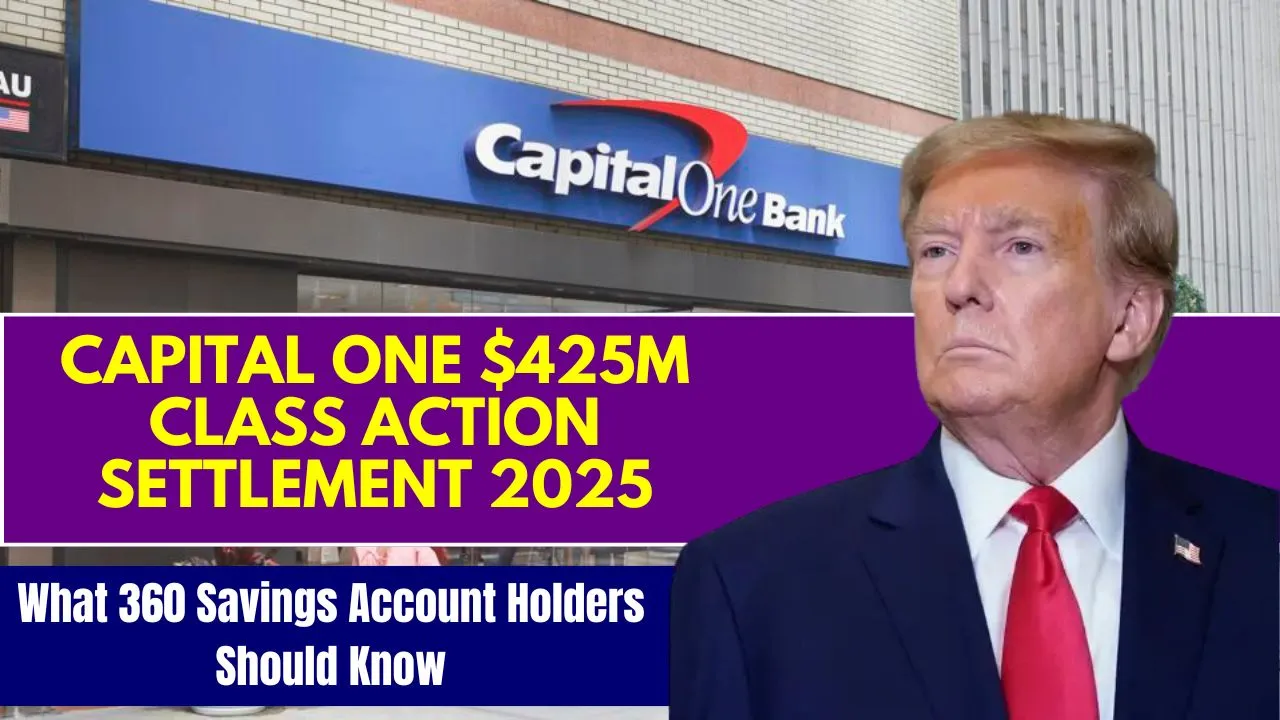Capital One $425M settlement : Capital One customers with legacy 360 Savings accounts may finally see justice. A major class action lawsuit has resulted in a proposed $425 million settlement, aiming to compensate account holders who were allegedly misled about better options. The bank was accused of failing to inform long-time customers about its newer, higher-yield 360 Performance Savings account, resulting in significant missed earnings.
The Capital One $425M settlement was filed in the Eastern District of Virginia in May 2025 and marks the resolution of a years-long legal dispute. Without admitting fault, Capital One has agreed to pay affected customers who maintained older savings accounts with lower interest rates. This article explains the background of the case, outlines who is eligible for compensation, and highlights what this means for account holders and the broader banking industry.
Capital One $425M Settlement: What It Means
The Capital One $425M settlement compensates customers who kept using legacy 360 Savings accounts while newer customers were earning more interest through upgraded accounts. The issue stems from Capital One’s alleged lack of communication about the improved product, despite it offering an annual percentage yield (APY) of 1.90%—almost double the 1.00% APY offered to older accounts. The lawsuit focused on the gap in returns and the bank’s failure to alert customers to this difference.
Overview Table: Capital One Class Action Details
| Detail | Information |
| Total Settlement Amount | $425 Million |
| Main Issue | Lack of communication on better interest savings account |
| Affected Product | Legacy Capital One 360 Savings Account |
| Higher Yield Account | 360 Performance Savings Account (1.90% APY) |
| Lower Yield Account | Original 360 Savings Account (1.00% APY) |
| Legal Filing Date | May 16, 2025 |
| Settlement Court | U.S. District Court, Eastern District of Virginia |
| Expected Final Approval | Late 2025 |
| Disbursement Type | Direct deposit, check, or digital payout |
Acquisition History and Account Structure Transformation
The roots of this case go back to Capital One’s acquisition of ING Direct USA in 2012. At the time, ING Direct was a pioneer in high-yield savings accounts. After the acquisition, Capital One rebranded those accounts as 360 Savings and continued offering them under the same structure. However, in 2019, a new product—360 Performance Savings—was introduced with a higher interest rate.
While this new account was available to all customers, it was not clearly promoted to legacy 360 Savings users. Customers who didn’t actively research and switch were stuck with a lower yield. This lack of transparency forms the basis of the lawsuit.
Nature and Scope of the Legal Allegations
The lawsuit was filed on behalf of consumers in 18 states and alleged deceptive practices, breach of contract, and violations of consumer protection laws. Customers argued that they were not informed about the 360 Performance Savings account, and that the marketing of this product excluded existing customers. The 0.90% APY gap, maintained for several years, led to substantial financial losses.
While Capital One tried to dismiss the claims, the court allowed the most serious allegations to proceed. In November 2024, a federal judge dismissed some charges but permitted the breach of contract and consumer deception claims to continue, leading to the eventual settlement.
Settlement Structure and Compensation Breakdown
The Capital One $425M settlement is split into two parts to fairly compensate affected customers:
- $300 million will go toward interest compensation. This is meant to reimburse users for interest they would have earned if their accounts had received the 1.90% APY.
- $125 million will be awarded to customers who still maintain 360 Savings accounts, recognizing their loyalty and continued losses.
The payment amount will vary for each individual based on account duration, average balance, and account status. Customers can expect official notices explaining their eligibility and how to claim compensation.
Criteria for Settlement Eligibility and Disbursement Plan
To receive a portion of the settlement, individuals must meet certain criteria:
- Held a 360 Savings account after the 2019 launch of the higher-yield account.
- Did not open or switch to the 360 Performance Savings account.
- Earned a maximum of 1.00% APY on their savings during the affected period.
- Can verify account ownership when contacted by the claims administrator.
Disbursement will be carried out through direct deposits for active accounts, mailed checks for closed accounts, or digital payments. The process will begin after final court approval, expected by late 2025.
Consumer Awareness and Banking Transparency Issues
This case has raised serious concerns about how banks communicate product upgrades. While Capital One argued that all information was publicly available, many customers claimed they were never notified. For customers who trusted the bank to inform them of better options, this lack of direct outreach felt like a betrayal.
It also brings up a wider issue in banking: institutions must go beyond passive disclosure and actively communicate changes that can financially affect their clients. Legacy account holders, especially, expect transparency and fairness from their banks.
Broader Implications and Industry Takeaways
Even though Capital One has not admitted wrongdoing, this case will likely change how banks handle account updates in the future. As more people turn to digital banking, the need for transparency and proactive communication has never been greater.
Key Lessons for Banks:
- Notify existing customers directly when new or better financial products are launched.
- Avoid marketing strategies that exclude legacy account holders.
- Monitor and evaluate whether older accounts continue to meet competitive standards.
Policy Impact:
- Consumer advocacy groups may push for stricter rules on product transparency.
- State-level enforcement of fair banking practices could become more aggressive.
This case sets an important precedent. Banks can no longer assume that public information is enough. They must ensure that all customers are equally informed, especially when it comes to earning potential.
Next Steps for Customers
If you’re a Capital One 360 Savings account holder and believe you’re affected, here’s what you should do:
- Look out for official communication from Capital One or the settlement administrator.
- Gather any account documents that can help verify your eligibility.
- Follow updates on the official settlement website for filing deadlines.
- Contact the administrator if you haven’t received notice but think you qualify.
Remember, payments won’t happen until after the court grants final approval, but preparing early will help you avoid delays.
FAQs
Q1. What is the Capital One $425M settlement about?
It’s a class action settlement compensating customers who earned less interest because they weren’t informed about a higher-yield savings account.
Q2. Who is eligible for compensation?
Anyone who had a 360 Savings account after 2019 and didn’t switch to the 360 Performance Savings account.
Q3. How will I receive the money?
Payments will be made via direct deposit, check, or digital payout, depending on your account status.
Q4. Do I need to take action to claim the money?
Yes, eligible customers will receive instructions. Be sure to respond promptly once notified.
Q5. When will the payments begin?
Payments will start after the court approves the settlement, expected in late 2025.
Final Thought
The Capital One $425M settlement is a significant reminder for both banks and consumers. Financial institutions must ensure transparency when launching new products. As for customers, this is a good time to review your savings options and ask questions about better alternatives. Stay informed, stay proactive, and if you’re eligible—make sure to claim your compensation.
Have thoughts on this case? Drop a comment or explore more updates on consumer settlements and banking news!












